Showing Spotlights 81 - 88 of 217 in category All (newest first):
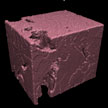 The robustness, accuracy, and validity of an atomistic simulations hinge on the appropriate choice of force fields. Force fields are key for modeling the interaction between atoms of a matter under study, and the challenge is to have an accurate force field working for any specific material at any desired temperature. To serve this objective and make a benchmark as well as a shortcut for users to find their best force fields, scientists have examined a number of force fields for materials that are popular in micro- and nanotechnologies.
The robustness, accuracy, and validity of an atomistic simulations hinge on the appropriate choice of force fields. Force fields are key for modeling the interaction between atoms of a matter under study, and the challenge is to have an accurate force field working for any specific material at any desired temperature. To serve this objective and make a benchmark as well as a shortcut for users to find their best force fields, scientists have examined a number of force fields for materials that are popular in micro- and nanotechnologies.
Jun 12th, 2017
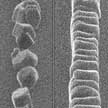 In recent years, researchers working on de-icing and anti-icing strategies have been inspired by biology and nanotechnology to develop nanocoatings and other nanostructured surfaces. Researchers now have demonstrated the ability to spatially control frost nucleation (ice formation from water vapor) and to manipulate ice crystal growth kinetics. This ice nucleation control and the confinement of ice crystal growth direction through manipulating roughness scale have not been reported before.
In recent years, researchers working on de-icing and anti-icing strategies have been inspired by biology and nanotechnology to develop nanocoatings and other nanostructured surfaces. Researchers now have demonstrated the ability to spatially control frost nucleation (ice formation from water vapor) and to manipulate ice crystal growth kinetics. This ice nucleation control and the confinement of ice crystal growth direction through manipulating roughness scale have not been reported before.
Mar 17th, 2017
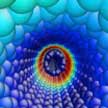 Carbon nanotubes (CNTs), by possessing a uniquely large disparity among its intertube and intratube interaction strengths, have been established as ultralow friction nanostructures and are serving as testbeds for tuning frictional response. In new woirk, researchers now have revealed the phononic origins of friction in CNT oscillators. This work, for the first time, provides a precise connection between individual phonon mode scattering and friction force.
Carbon nanotubes (CNTs), by possessing a uniquely large disparity among its intertube and intratube interaction strengths, have been established as ultralow friction nanostructures and are serving as testbeds for tuning frictional response. In new woirk, researchers now have revealed the phononic origins of friction in CNT oscillators. This work, for the first time, provides a precise connection between individual phonon mode scattering and friction force.
Mar 6th, 2017
 Here are the 10 most popular Nanowerk Nanotechnology Spotlight articles of 2016. This year, the list includes nanotechnology in textiles; nanotechnology for next-generation inkjet color printing; graphene-based smart contact lens works as self-powered biosensor; nanotechnology's tiny steps toward atomic-scale 3D fabrication; stick-on epidermal electronics tattoo to measure UV exposure; a nanotechnology approach to scavenging wind and solar energy in cities; 3D printing highly conductive nanocomposites; using household items to make a multi-sensory 'Paper Skin'; an analogue smart skin that is self-powered; and writing nanotubes with a nano fountain pen.
Here are the 10 most popular Nanowerk Nanotechnology Spotlight articles of 2016. This year, the list includes nanotechnology in textiles; nanotechnology for next-generation inkjet color printing; graphene-based smart contact lens works as self-powered biosensor; nanotechnology's tiny steps toward atomic-scale 3D fabrication; stick-on epidermal electronics tattoo to measure UV exposure; a nanotechnology approach to scavenging wind and solar energy in cities; 3D printing highly conductive nanocomposites; using household items to make a multi-sensory 'Paper Skin'; an analogue smart skin that is self-powered; and writing nanotubes with a nano fountain pen.
Dec 30th, 2016
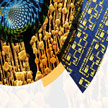 Written by Nanowerk's Michael Berger, this just published book is a collection of essays about researchers involved in all facets of nanotechnologies. Nanoscience and nanotechnology research are truly multidisciplinary and international efforts, covering a wide range of scientific disciplines such as medicine, materials sciences, chemistry, biology and biotechnology, physics and electronics. Each of the book's chapters is based on a scientific paper that has been published in a peer-reviewed journal. Although each story revolves around one or two scientists who were interviewed for this book, many, if not most, of the scientific accomplishments covered here are the result of collaborative efforts by several scientists and research groups, often from different organizations and from different countries.
Written by Nanowerk's Michael Berger, this just published book is a collection of essays about researchers involved in all facets of nanotechnologies. Nanoscience and nanotechnology research are truly multidisciplinary and international efforts, covering a wide range of scientific disciplines such as medicine, materials sciences, chemistry, biology and biotechnology, physics and electronics. Each of the book's chapters is based on a scientific paper that has been published in a peer-reviewed journal. Although each story revolves around one or two scientists who were interviewed for this book, many, if not most, of the scientific accomplishments covered here are the result of collaborative efforts by several scientists and research groups, often from different organizations and from different countries.
Aug 31st, 2016
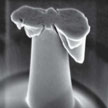 Whether it is possible to achieve high formability in quasicrystals and how quasicrystals are plastically deformed at room temperature have been long-standing questions since their discovery. In new work, an international group of researchers has found that a typically brittle quasicrystal exhibits superior ductility (ductility is a solid material's ability to deform under stress without fracture) at the sub-micrometer scales and at room temperature. Furthermore, their experiments indicate that 'dislocation glide' could be the dominating deformation mechanism for quasicrystals under high-stress and low temperature conditions, which has been not poorly understood before.
Whether it is possible to achieve high formability in quasicrystals and how quasicrystals are plastically deformed at room temperature have been long-standing questions since their discovery. In new work, an international group of researchers has found that a typically brittle quasicrystal exhibits superior ductility (ductility is a solid material's ability to deform under stress without fracture) at the sub-micrometer scales and at room temperature. Furthermore, their experiments indicate that 'dislocation glide' could be the dominating deformation mechanism for quasicrystals under high-stress and low temperature conditions, which has been not poorly understood before.
Aug 12th, 2016
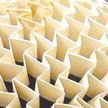 Poisson's ratio describes the fundamental elasticity of any solid. Poisson's ratio has been a basic principle of engineering for more than 200 years as it allows engineers to identify how much a material can be compressed and stretched and how much pressure it will withstand, before it collapses. Materials with a negative Poisson's ratio are relatively rare and it has recently become popular in referring to them as metamaterials - a group of materials that attain interesting or extreme properties via structure rather than composition.
Poisson's ratio describes the fundamental elasticity of any solid. Poisson's ratio has been a basic principle of engineering for more than 200 years as it allows engineers to identify how much a material can be compressed and stretched and how much pressure it will withstand, before it collapses. Materials with a negative Poisson's ratio are relatively rare and it has recently become popular in referring to them as metamaterials - a group of materials that attain interesting or extreme properties via structure rather than composition.
Aug 3rd, 2016
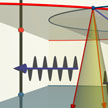 A theory analysis of energy / momentum conservation laws in a spatially confined coupled system of nearly free electrons and phonons hints that the absorption of electromagnetic waves by a metallic nano-object hosting longitudinal vibration modes may allow channeling the absorbed energy either into heat or into terahertz radiation, depending on the nano-objects' shape and size. This offers an explanation for the size selectivity of small nanoparticles in radio frequency hyperthermia, and suggests design for novel terahertz radiation sources.
A theory analysis of energy / momentum conservation laws in a spatially confined coupled system of nearly free electrons and phonons hints that the absorption of electromagnetic waves by a metallic nano-object hosting longitudinal vibration modes may allow channeling the absorbed energy either into heat or into terahertz radiation, depending on the nano-objects' shape and size. This offers an explanation for the size selectivity of small nanoparticles in radio frequency hyperthermia, and suggests design for novel terahertz radiation sources.
Jul 11th, 2016
 The robustness, accuracy, and validity of an atomistic simulations hinge on the appropriate choice of force fields. Force fields are key for modeling the interaction between atoms of a matter under study, and the challenge is to have an accurate force field working for any specific material at any desired temperature. To serve this objective and make a benchmark as well as a shortcut for users to find their best force fields, scientists have examined a number of force fields for materials that are popular in micro- and nanotechnologies.
The robustness, accuracy, and validity of an atomistic simulations hinge on the appropriate choice of force fields. Force fields are key for modeling the interaction between atoms of a matter under study, and the challenge is to have an accurate force field working for any specific material at any desired temperature. To serve this objective and make a benchmark as well as a shortcut for users to find their best force fields, scientists have examined a number of force fields for materials that are popular in micro- and nanotechnologies.
 Subscribe to our Nanotechnology Spotlight feed
Subscribe to our Nanotechnology Spotlight feed





